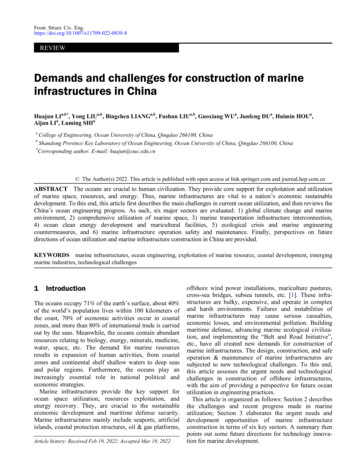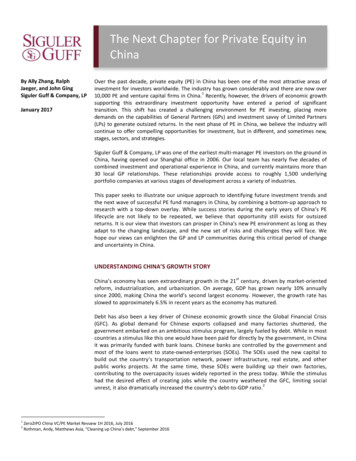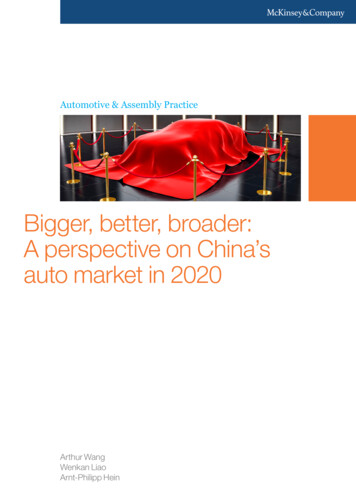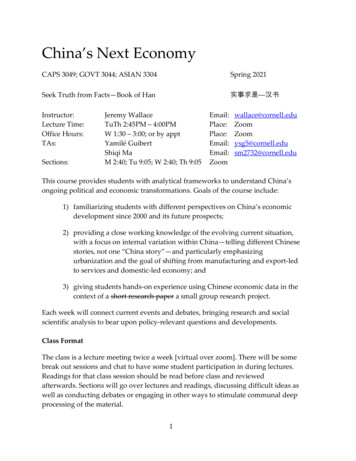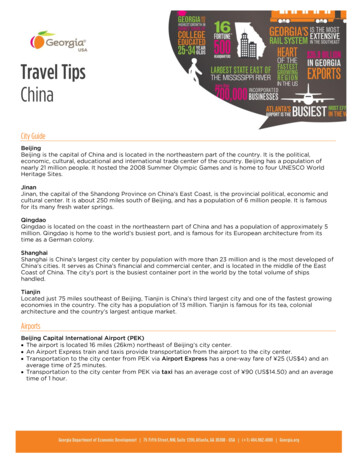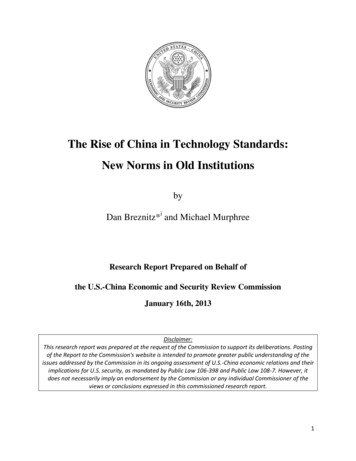
Transcription
The Rise of China in Technology Standards:New Norms in Old InstitutionsbyDan Breznitz*i and Michael MurphreeResearch Report Prepared on Behalf ofthe U.S.-China Economic and Security Review CommissionJanuary 16th, 2013Disclaimer:This research report was prepared at the request of the Commission to support its deliberations. Postingof the Report to the Commission's website is intended to promote greater public understanding of theissues addressed by the Commission in its ongoing assessment of U.S.-China economic relations and theirimplications for U.S. security, as mandated by Public Law 106-398 and Public Law 108-7. However, itdoes not necessarily imply an endorsement by the Commission or any individual Commissioner of theviews or conclusions expressed in this commissioned research report.1
Executive SummaryChina’s efforts to develop unique technology standards and its rapidly increasing activities as aparticipant in international standardization efforts have drawn widespread attention. China doesuse technology standards as a protectionist tool. However, a complete review of thestandardization system reveals that: i) protectionism is not the major focus of Chinese standardsdevelopment efforts; and ii) it is not the main challenge China poses for American firms. Thisreport addresses six broad areas of interest that are critical to understanding Chinese technologystandards efforts and their implications: Unique or exclusionary technology standards have neither been commercially successful norfully exclusionaryUnique standards efforts are an effective trade tool, particularly in lowering royalty rates forChinese firmsThe main challenge China poses in standardization is in establishing new norms, particularlyadvancement of a cheap royalty options to the holders of standards-essential IntellectualProperty Rights (IPR)China is rapidly increasing its skill and sophistication in global standards organizations andbuilding deep knowledge of their regulations, fostering potential advantages in negotiationsTechnology standardization in China remains legally governed by laws and administrativeapparatus developed for, and at the time of, the planned economyAn expansive role for the state in standardization is the accepted norm in ChinaUnique Chinese standards development efforts, particularly in information and communicationtechnologies, including TD-SCDMA (Mobile), WAPI (Wireless LAN encryption), and AVD andCBHD (Digital disc players) have attracted attention. Many see these standards as outgrowths ofChina’s “indigenous innovation” policy. The policy of promoting indigenous innovation is notclear-cut, as there is no universal agreement on what constitutes indigenous innovation. UniqueChinese standards have also generally been market failures. None have gained significant marketsupport outside of China and most have limited success even within China. These standards alsoincorporate significant amounts of foreign intellectual property. For TD-SCDMA, foreign firms’patents constitute the majority of the embedded patents.On the other hand, unique Chinese standards successfully serve as a trade tool. As exportprocessors, China’s firms specialize in the final assembly, packaging, testing, and shipment ofcompleted products. For these goods, Chinese manufacturers are subject to the licensingrequirements of different standardized technologies. In commoditized industries such asconsumer electronics, licensing fees squeeze already thin profit margins. Development of lowcost and potentially competitive standards for similar or identical technology niches pushesforeign standards alliances to lower royalty rates. This has been a great boon to Chinesecompanies.The approach to intellectual property embedded in technology standards has been evolving.China’s Patent Law permits inclusion of proprietary technologies in standards, but the termsunder which firms are obligated to license remain ambiguous. This is an area of great concernand contention for foreign enterprises interested in participating in standards development work2
in China. The fear is that proposed changes would mean that the act of participation wouldobligate firms to license their intellectual property. Under the current ambiguous legalenvironment, policies for IP in standards are de facto the responsibility of the various standardsdevelopment organizations and industry alliances. Each of these organizations is developing itsown policies. Formally, all groups accept and conform to Reasonable and Non-Discriminatory(RAND) principles. Nonetheless, preference is often given to technologies whose IPR is offeredon either a royalty-free or minimal and set-price royalty basis. Similarly, some groups havebegun using patent pools that set very low royalty rates for embedded essential IP. Thus, theoverall trend in China’s policy is toward establishing the norm of a set, low, cash-option (that isnominal cash payment, for example 50 cents, for the licensing of all IPs that are embedded in astandard) on the licensing of essential standards’ IP.It is here – in its potential reshaping of norms for standards-essential IP – that China’s ascentposes a real challenge to American firms’ practices. The Chinese approach emphasizes IP asanother factor of production, not as a source of profit or unique competitive advantage.Accordingly, the aim is to lower its price to the minimum, which would (hopefully) increase theprofit margin of equipment producers at the expanse of the IPR holders.China is rapidly increasing its skill and sophistication in global standards organizations. TheChina National Institute for Standardization is developing masters-degree programs intechnology standardization. These programs train engineers to focus on the legal and policyaspects of technology standards development. Deep understanding of the laws and regulationssurrounding standards increasingly make Chinese contributors highly effective in promotingChina’s interests in international standard setting bodies.The legal and agency structure for standards dates to the 1980s, when the National People’sCongress developed and approved two sets of legislation critical for technology standards: thePatent Law (1984) and the Standardization Law (1989). The Patent Law has since been amendedthree times, taking into account the growth of the market economy and the increased role ofbusiness R&D. The Standardization Law has not been amended since 1989. It places the state –specifically, the Standardization Administration of China (SAC) – at the center ofstandardization efforts. SAC is to initiate, guide, and approve national standardization efforts.Trade (industry) standards are initiated, guided, and approved by industrial ministries, mostnotably the Ministry of Industry and Information Technology (MIIT). The law does not addressintellectual property, licensing, and the role of industrial standards alliances. These areas areopen to interpretation and divergent practices by standards development organizations. The lawallows for two types of standards: compulsory and voluntary. Compulsory standards have theforce of law and can bar non-compliant products from the market.Last, but certainly not least, China’s strategy for standards is state-centric and regulation-basedwhile the United States insists on market leadership and voluntary standards. There is a majorand accepted role for the government in China’s technology standards development. Industrialministries support strong state involvement in standards but also insist that standards besubjected to market forces, not just state dictate. The use of state power in standards-making isintended to give Chinese firms an opportunity to develop and test technologies domesticallybefore seeking their inclusion in international standards.3
IntroductionOn some measures Chinese advancement in advanced R&D and innovation is striking; starting atpractically zero in 1990, by 2012 China annually exported over 548 billion dollars in hightechnology goods and services (MOST, 2012). R&D expenditure is growing, nearly 22% peryear, and reached 136 billion USD, second only to the United States, (BBC, 2011; Xi Wang &Liu, 2012). In patenting, China was ranked third globally by 2008 and surpassed Japan asnumber two in 2010 (Finance.591hx, 2011). China’s scientific publications have also surged,ranking second only to the United States and leading in certain emergent fields such asnanotechnology.1It is no surprise that China has set its sights on achieving what it sees as its due globalstature in the technology standards domain. By 2020, according to the Chinese government,China should have an innovation-based economy and be a world-leading R&D power(StateCouncil, 2006). Policy makers see development of technology standards as central torealizing these objectives. Within China, particularly in policy circles and academia, there is apervasive belief that only companies that make standards can be considered first tierinternational technology-based companies.2 Furthermore, it was widely argued that to achievethe goal of establishing standards-setting firms, the government must play an active role in1It should be noted that in these statistics, similarly to many statistics used in the case of technology standards, thereis an acute misunderstanding of the meaning and the causes behind this surge. For example, in the case of scientificpublications much of the explosion can be explained by means other than a radical qualitative change of the entiretyof Chinese research output in less than a decade. Simply looking at the journals themselves, one realizes that almostall the publications are in new ISI indexed scientific journals that have been established and managed by Chinese inChina over the last fifteen years after a new incentive system for academics placed emphasis and material rewardson publication in ISI-cited journals. Thus, while the surge is nothing but miraculous, and hints at significantunderlying changes, scholars who use aggregate statistics to reach sweeping conclusions on innovation rankingsoften miss their mark by a wide margin (Murray & Spar, 2006; Porter, Newman, Roessner, Johnson, & Jin, 2009).2A popular Chinese saying states: 三流企业做产品; 二流企业做技术; 一流企业做标准 (Third tier companiesmake products; second tier companies make technology; first tier companies make standards).4
mandating and setting standards. In interviews, many policy makers and academies voiced asimilar sentiment as stated by a leading researcher at Tsinghua University:“Globalization is all about the move from national markets to a global market. Wherethere is a single global market, the first mover wins. Standards can create a relativelyprotected environment to allow indigenous firms and technology to develop. Otherwisethe first mover, who comes most often from a developed country, will dominate.Emerging economies are coming from behind and cannot compete on the same terms asestablished technology players. Thus the state should be more active in providing thenecessary protected environment.”With this underlying perception, the Chinese state apparatus has moved strongly topromote new indigenous technologies and standards incorporating them. However, it has done sousing a hybrid administrative and institutional system born under the planned economy anddeveloped gradually and without explicit direction throughout the reform era. China’s moves todevelop unique, and at times mandatory, technology standards have stunned dominant foreigntechnology companies, yet until now these standards have repeatedly failed when introduced intothe market. However, as we argue below, failure to reach success in the market does not meanthat these standards have not served a valuable purpose for Chinese firms.We argue that China’s technology standards policy, while ambitious, is far from amonolithic strategic objective. The reader should remember that China is far from a singleminded strategic actor. Its formal organizations and institutions of standardization are stilldeveloping and changing, many of them still tied to a legal and agency infrastructure developedfor a centrally planned economy. Bureaucratic infighting often undermines the potential marketsuccess of Chinese standards, even those which ostensibly present a real technological challengeto the West. The use of embedded formal intellectual property rights – such as patents – instandards is only recently emerging. Most importantly, we contend that, based on the businessmodels of Chinese technology firms, China’s real challenge to the West is not in developing5
unique alternative technologies and standards; but rather in affecting changes in the normsgoverning the means by which embedded IP in standards is monetized and licensed.This white paper is based on the results of archival, statistical and secondary sourceresearch, as well as three months of field research conducted in the spring and summer of 2012.Archival research included consulting official Chinese policy and legal documents, standardsdrafts, and circulars. Statistics were provided by China’s standardization administration, theMinistry of Science and Technology, the State Intellectual Property Office, and interviewees.Secondary source research included both media and academic publications and white papers inEnglish and Chinese from foreign and Chinese sources.The field work involved the use of semi-structured interviews. Each interview utilized aseven-point interview theme instrument; all of the themes were at least partially addressed ineach interview. (Using semi-structured interviews as opposed to surveys enabled interviewees tospeak more fully on topics of interest to them or areas where they had greater expertise.) Thussome interviews focused heavily on the role of IP in standards and China’s evolving IP systemwhile others emphasized strategy and theory for standards in China’s economy. Intervieweesrepresented the various stakeholders in China’s technology standards bodies, governmentministries, technology companies, academia and consulting firms.In total, we performed over sixty semi-structured interviews. Interviewees included bothChinese and foreigners, providing a wide range of insights and perspectives into China’stechnology standards system and policies. Meetings were held in Beijing, Jinan, Hong Kong, andXiamen. As the center of China’s political system and home of most standards-making bodies,the majority of interviews were held in Beijing. The interviews were conducted in Chinese orEnglish according to the interviewees’ comfort level; the majority were conducted in Chinese.6
Wherever possible, we verified the claims of interviewees by triangulating responses with thoseof other interviewees or published accounts and research.This research has shown that China’s technology standards system is still maturing andhas developed several unique and defining characteristics that have an impact on the standardsproduced, the interests of foreign (and Chinese) firms, and that ability of foreign companies tocontribute to technology standard development efforts: China’s technology standards system, and the active role for the government in pushingstandards development, is governed by the 1989 technology standardization law of China.This law was made while China was still largely under the planned economy, and eventhe nascent reform movement was heavily government led and directed. As the legalbasis for China’s technology standards system and administration, the leading role for thegovernment – specifically the central government – remains the law in China to this day.Recent attempts to reform the law have not diminished state leadership in standards, andthey have not yet been successful in radically changing policies for incorporation ofprotected IP into standards.Voting in Chinese technical committees and working groups is not the source of majordecisions or changes in membership or incorporation of technology. US firms should paycloser attention to the actual structure of decision making within each body, instead offocusing on formal procedural mechanisms like voting.China’s emerging approaches to embedded-IP in standards differ from the US norm andpresent a challenge to monetized IP-based business strategies. Chinese firms andstandards-making bodies increasingly favor low-price or free licensing norms forembedded technology.Although interested in using standards as a means of technological upgrading, China’sunique or exclusionary standards development efforts have not been commerciallysuccessful; neither have they been effective in supplanting foreign embedded intellectualproperty in ostensible Chinese technologies and standards.However, China’s unique standards development efforts are very effective as trade andcommercial negotiation tools, specifically in lowering royalty rates that Chinesecompanies pay for licensing.China’s overall view of technology standards and the role for the state (versus market) indetermining their formulation and composition is more akin to a European perspectivethan that of the United States.The Chinese now have a much better understanding of the specific wording ofinternational agreements about standards, to include what practices are allowed, when,and how. As a result, China’s international negotiators are becoming more adept thanthose in the United States. It is, therefore, no longer clear whether the US would prevailagainst Chinese efforts in cases of standards disputes at the international level.7
This white paper develops these arguments as follows. It first introduces the basicprinciples of technology standards, standards development and embedded intellectual property(IP) as practiced in the West and in international organizations. It then turns to China,introducing the influential 1989 Standardization Law, the legal basis for China’s approach totechnology standards. With this background, the paper then looks at China’s standardizationsystem and the actual workings of China’s technical committees and standards bodies, and howthese shape the types of standards developed. It then explores how China approaches theincorporation of essential intellectual property into national and industry technology standards.Then, it presents a discussion of the relative success of China’s attempts to develop uniqueChinese technology standards, highlighting the effective, if unintentional, role these efforts playin the setting of licensing fees for Chinese manufacturers. Finally, the paper presents a briefdiscussion of the broader implications of China’s unique standards development efforts for USfirms and the position of China and the United States in the international standardization system.Technology Standards in BriefTechnology standards are agreed-upon technology platforms for interconnection,operation, or function on which other applications, improvements, and innovations can be made.Like patents, the formal documentation for a standard consists of hundreds of pages of technicalspecifications defining terminology, outlining protocols and specifying the technologiesnecessary to make the protocols function. Since the time of the unification and centralizedcodification of weights in Qin-era China, and medieval Florentine guild-masters checking thelength of cloth merchants’ meter-sticks, standards have traditionally been the staid domain ofgovernment weights and measures officials (Kindleberger, 1983). Even in those early days,however, standards were essential to the smooth operation of trade – hence the Florentine8
insistence on controlling against “short sticks.” Today, this importance has only increased.Standards of quality facilitate trade through lowered transaction costs and increased efficiency.For example, the difference in standard railroad gauges between Russia and China forces railroadoperators to exchange the railcar carriages at the border, slowing trade. Similarly, internationaltravelers know well the irritation of being unable to use different electronic devices due tovoltage differences and incompatible plug styles. On the other hand, standardized measures ofquality enable potential buyers to acquire goods or services sight unseen with a measure ofconfidence.Technology standards are integral to modern life. Information and communicationtechnology (ICT), particularly its ability to communicate with other devices, is reliant uponwidely adopted and accepted standards. Whether internationally developed such as the ISO’sOSI suite or DARPA’s TCP-IP, commonly accepted protocols are necessary for electronicdevices to communicate and exchange data. To illustrate, the Universal Serial Bus (USB),developed by a group of US computer firms including Intel, IBM, and Microsoft, has become theglobal standard for interfacing computer peripherals with the main system. The USB standardhas replaced the need for multiple incompatible jacks that had made it difficult to design andmarket products for any and all types of personal computers. Use of USB has helped alleviatemarket confusion and increased the market for peripherals as buyers can confidently purchasehardware assured of its compatibility with their computer system, regardless of brand. 3While there may be, and often are, competing standards for a given technology – forexample GSM and CDMA in second generation wireless telecommunications – technologystandards often achieve quasi-monopoly status in world markets. For example, although there arecompeting software options including free open-source and online tools, Microsoft’s Office suite3The market success of USB is such that both Apple and PC-brands all use it as the basic connection interface.9
dominates the global market in word processing, spreadsheets, and presentation software. Thisde facto monopoly enhances Microsoft’s brand value and makes it difficult for competing (andeven potentially better) technologies to take root in the market.4 Firms whose technology isincorporated into a dominant standard stand to earn massive returns, while those who supporteda losing standard might find their R&D investment wasted.5Technology standards can be either market-based de facto or de jure (formal) standards.De facto standards such as Microsoft Office are set through market competition where thewinning standard or format pushes competitors out. An important point, and one sadly muchconfused in the media, is that a technology standard – even a market determined de facto one – isnot usually a product by itself. While Microsoft software tools are products, even DVDtechnology is not actually a product but rather a codified set of technologies which, if adhered to,make a player compatible with the standard. DVD players are products, devices certified ascompatible with other devices and media adhering to the same protocols. Technology standardsare incorporated into goods and services to make them compatible with, or in compliance with,regulations or even technological necessity (such as how to continue squeezing ever more datatransmission into finite amounts of broadcast-worthy spectrum). Only when the standard isincorporated into products does it have an impact. In our research, Chinese enterprisesconsistently emphasized the importance of standards in products, not the monetary value of thestandard – or even embedded IP – by itself. This critical difference will be highlighted in ourdiscussion of Chinese approaches to IP and the challenge this may present to US firms.4Through the “network effect” in which more users adopting a given technology can exponentially increase thattechnologies’ value due to the number of compatible partners. As such standards such as Microsoft Office becomedeeply entrenched. Known as “Metcalfe’s Law”, this method of valuation has been used to explain the value ofsocial networks, computer networks and the Internet.5The victory of Sony’s Blu Ray over Toshiba’s HD-DVD standard led Toshiba to license its technology at very lowrates to Chinese firms in order to cut its losses. Chinese firms went on to use this technology as the basis for theindigenous China Brand High Definition violet laser disc standard. Expert analysis estimates 90% of the technologyfor the Chinese standard came from HD-DVD (Hsu & Hwang, 2008).10
Formal or de jure standards are developed, set, and administered by institutionalizedtechnology standards bodies. These can be non-governmental organizations with globalmembership, such as IEEE, or state membership-based bodies such as the InternationalTelecommunication Union (ITU) and International Organization for Standardization (ISO).6 TheUnited States considers international market-determined standards and those set by NGOs suchas IEEE to be international standards that should be accepted as mandatory under WTO rules.However, European Union members and China insist that only formal inter-governmental bodiescan make binding international standards. This has become an area of contention in US-Chinarelations governing standards (AMCHAM, 2012; USITO, 2010).At the national level, there are non-governmental bodies, such as the American NationalStandardization Institute (ANSI) or European Technical Standards Institute (ETSI) that definenational or regional standards. These are generally not standard-making bodies themselves.Rather, they are administrative bodies and represent their respective states in formal intergovernmental standards organizations (such as the ISO). While able to certify compliance, theseactors too lack an independent means of enforcement of their standards. Some national standardsbodies (such as the German Institute for Standardization) draft, adopt, and certify nationalstandards. Generally there are not formal government bodies; however their actions, as in theUnited Kingdom, may be certified as official for the country in question.To develop standards, specific technical committees are established to draft the protocolsfor a given technology or area of interest. Technical committees may be organized either by6IEEE is a professional organization made up of experts from electrical and electronics engineering. It setsstandards for electronic and local wireless communications technologies. It has no enforcement capability of its own.ISO and ITU are state-based organizations whose membership is limited to representatives of different countries.These bodies set broad ranges of standards – such as ISO – or more narrowly focused ones – such as ITU whichonly sets long-range telecommunications standards. These organizations also have no formal enforcement capabilitybut do certify products or technologies as compliant with their standards, thus providing consumer confidence abouttheir interoperability.11
industry directly, or under government aegis through national standards bodies. Within technicalcommittees, working groups of experts propose, test, debate, and adopt protocols to incorporateinto the final standard. Inclusion of technologies or approval of protocols is accomplishedthrough consensus and majority vote.Binding enforcement of standards set by the IEEE or international organizations such asthe ISO is accomplished through the World Trade Organization. In response to the use oftechnology standards as a trade barrier in the 1970s and 1980s, the Uruguay Round of the GATT,which formally created the WTO, incorporated language regarding technology standards into theTechnical Barriers to Trade (TBT) agreement. According to the 1995 TBT agreement text:“Where technical regulations are required and relevant international standards exist ortheir completion is imminent, members shall use them, or the relevant parts of them, as abasis for their technical regulations” (WTO, 1995).In effect, the TBT agreement requires WTO members to use internationally accepted standards,except where there are significant security or local country challenges. WTO members whoadopt non-conforming technology standards may face retaliatory action by offended partiesthrough the WTO’s arbitration apparatus. Unique compulsory standards can be used as a tradebarrier and are thus banned under TBT rules. However, it is very difficult to prove that atechnology standard, compulsory or otherwise, is actually intended to be exclusionary. WTOrules also allow for exceptions based on national conditions, which means that intent to disrupttrade must be proven. While the TBT agreement makes compliance with international standardsenforceable, the WTO arbitration mechanism is rarely used. To date, only a single standardsbased case has been brought for arbitration, concerning a European attempt to restrict use of theword “sardines” (WTO, 2003). Furthermore, the definition of an “international” standard is itselfsubject to contention. The United States’ official position is that formal standards set byintergovernmental bodies such as the ISO and those set by NGOs such as IEEE are international12
standards for TBT purposes. However, European states and China argue that onlyintergovernmental body-created standards are international, and therefore obligatory.The inclusion of protected intellectual property (IP) in technology standards throughIEEE, ISO or other bodies is done in accordance to the good faith disclosure principle. This isthe standard norm governing how firms should make their IP known and available for inclusionin the protocols of technology standards. Companies whose representatives are taking part in thedevelopment of a standard, or which are active in technology areas covered by a prospectivestandard, are expected to proactively disclose any patents that may be infringed by the proposedstandard. This is usually accomplished by a “patent dump” where firms simply list virtuallyevery potentially relevant patent they have.7 As the protocols of a standard are refined, it ideallybecomes clear which patents may be infringed upon and therefore the standards committee
With this underlying perception, the Chinese state apparatus has moved strongly to promote new indigenous technologies and standards incorporating them. However, it has done so using a hybrid administrative and institutional system born under the planned economy and developed gradually




